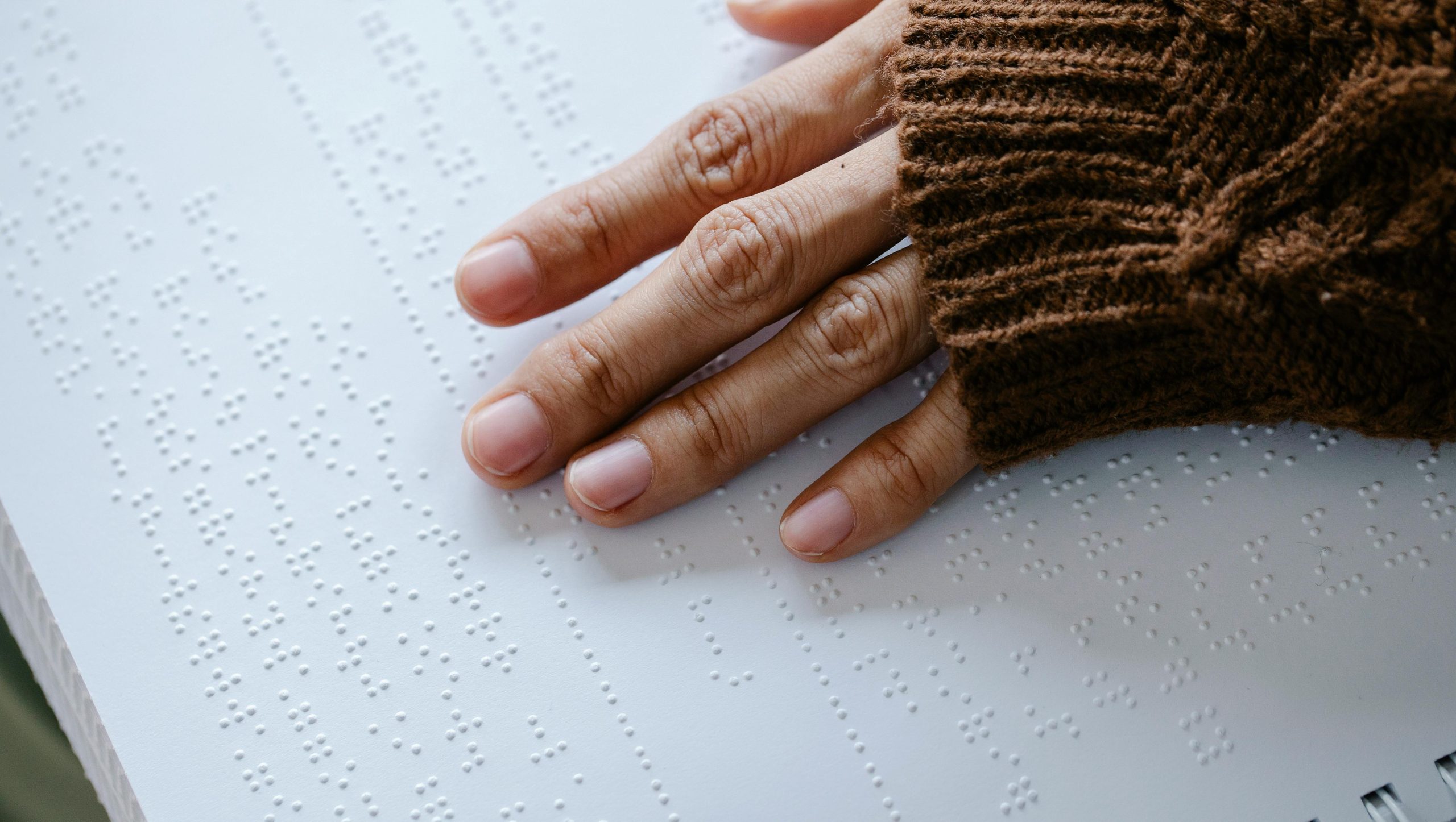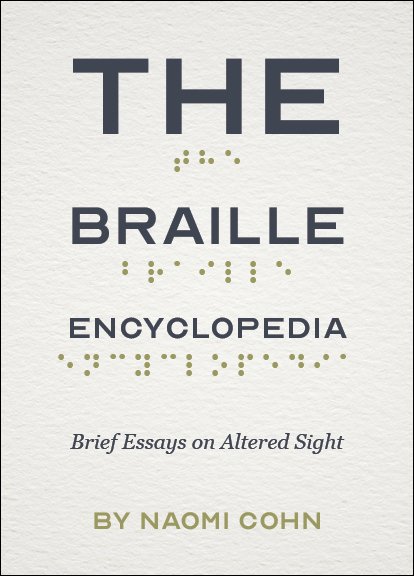Naomi Cohn’s memoir focuses on her progressive vision loss and her embrace of braille as an act of reclaiming her love of reading and writing, along with an expanded sensory and sensual existence in the world. Intertwined with this focus are themes braided and bountiful, including a history of Louis Braille and his writing and reading system, a medical narrative of her declining eyesight, her academic parents’ intellectualism, and her love of nature, art, and drawing. Conveyed in short non-chronological essays organized as alphabetical encyclopedia entries, The Braille Encyclopedia: Brief Essays on Altered Sight is a poetically rich narrative, replete with abecedarian index, on releasing former dreams to immerse oneself into pleasurable new ones that become, as she writes, “my real work.”
Naomi Cohn and I lived next door to each other for more than 25 years in St. Paul, Minnesota, leading parallel lives as writers. We talked on the phone about her memoir’s abecedarian structure, how braille opened up a tactile world of sensory reading and writing, her wry sense of humor, and her adaptations to a world of altered sight.
Camille LeFevre: Naomi, in your book you note Rebecca Solnit’s The Encyclopedia of Trouble and Spaciousness as inspiration for The Braille Encyclopedia. Your childhood passion for The International Wildlife Encyclopedia also figures thematically throughout the essays. Why did the abecedarian approach serve you in crafting and organizing your book?
Naomi Cohn: I read Solnit’s book as I was starting to explore personal essay after years of focusing on poetry. The way she used alphabetical form made me think, this is a perfect way to organize my work. But I wondered how much I wanted to mimic a traditional encyclopedia, which can be dry, unemotional, and fact-y. And does everything in it have to be provable? Or claiming a stance of expertise? Meanwhile, the project morphed from an essay into prose poems and finally a memoir. Going the abecedarian route freed me from chronology, from single dramatic points in time, because that’s not my experience of going blind. I’ve spent 30 years tackling all of the topics in the memoir; the encyclopedia was a great scaffold in the early stages. But then I’d find the memoir was missing an emotional note or piece of crucial information; that the book needed more about my parents or Louis Braille, and new topics emerged in the magic space between that scaffold and what the book needed.
CL: Why the term “altered sight” and how does that resonate throughout the memoir for you?
When I began learning braille, I reclaimed my love of reading and a way of writing that isn’t digital.
NC: I choose that term for a practical reason. I wanted the title to be invitational. I have my own baggage about blindness and readers may bring their own baggage. I wanted a term less loaded than “blind,” and with more of a sense of possibility to it. One theme of the book is that I truly feel two things at once that are contradictory: my love of reading and writing, and coming to realize there are different ways of seeing. No one can see everything at once. Some see less well, which means other things come forward, which is also a metaphor for how we exist in the world. Having the capacity to read braille, to take in language through my hands, is expansive. It’s amazing, right? So, my narrative arc of being a sighted person to becoming legally blind in my 60s reflects both a terrible loss and an evolution into different ways of being, and is a way of living and inviting the reader into both those truths.
CL: A great example, in your book, is your “reading” of Vermeer’s painting “Woman in Blue Reading a Letter” as an abstraction of meaning and metaphor.
NC: Yes. When I could see, I could make out details. Being legally blind allowed me to focus on the abstraction I couldn’t see in my 20s. Moreover, a key focal point in the painting is a letter gripped in a woman’s hands as she reads it, but the viewer, even a fully sighted one, can’t read the letter. The image, then, to me is more about a sensual relationship with reading, which is how I experience my relationship with braille.
CL: Right, and your tactile descriptions of learning braille have me wondering how reading and writing have become more embodied for you than when you were sighted.
The dots under my fingers could be a book and a whole world.
NC: It’s a love affair. It’s all about touch. While I was losing my vision, I’d still read print but the eyestrain became self-injurious at a certain point. Then I got books on tape in specialized formats. Now there are all sorts of technologies for auditory and text-to-speech reading. But when I began learning braille, I reclaimed my love of reading and a way of writing that isn’t digital. Even though it was arduous at first. Such a puzzle. A mystery, that the dots under my fingers could be a book and a whole world. But each stage of difficulty, every stage of learning, brought me into an awareness of what’s so wonderful about reading and writing: They are actions we do with our bodies. I’m constantly aware of the magic of that. When I read braille, even if I’m scattered and worried about 10,000 things, I put my fingers on the page and I’m centered and grounded and brought back into my body.
CL: I’m constantly amazed, in real life and in your book, at your resilience; at your ability to transform life-changing challenges into new-life experiences.
I put my fingers on the page and I’m centered and grounded and brought back into my body.
NC: I can’t sit on a park bench and observe like I used to. I make visual mistakes, like saying hello to mailboxes and real-estate signs because they might be people. In my teaching with older adults and people with disabilities, I try to model imperfection, like typos. Some of my students mis-hear things in interesting ways. What I’m getting at is that one of disability’s gifts is creativity; disability requires creativity just to get through the day. Many things require a hack to figure out. Louis Braille inventing a tactile writing system is an amazing creative hack. So that’s baked into disability experience. If we’re lucky we develop that creativity muscle and don’t have to apply it only to making sure we have clean underwear, food, and shelter. My blindness is an asset; it’s made me more creative. The natural habit of adaptation is also a creative habit.
CL: Your memoir runs counter to expectations in many ways. In its form. In its can-do tone, but without toxic positivity. In the humor you discover in what sighted people may find harrowing situations. Woodshop classes for the blind! Who is Naomi as a character in your memoir?
NC: I love this question. Because as memoir, the book has an arc of overcoming and understanding. But the book’s non-traditional, quirky shape is deeply related to my life experiences. People read memoir because they’re curious about other people’s lives, or want to figure out their own life. My experience is not here to entertain a reader. Nor am I engaging in self-exploitation. I’m not the most touchy-feely person; nor do I melt down into puddles in the book. That is true to who I am, and it’s also a character choice. Sure, there are moments in my life when I’m a weeping creature with fangs. But that’s not where the book spends its time. The humor is baked in. It’s genuine to who I am. That’s also a classic way of moving through the world to set people at ease when you present a problem to them, such as a disability.
My blindness is an asset; it’s made me more creative.
CL: Naomi, as neighbors, we were both childless cat ladies. So why are there so many dogs, and no cats, in your memoir?
NC: I love cats and still dream about my cats who have passed on. But there’s a way in which the dog is a more enthusiastic and sensual experiencer of the world. And that’s part of what I hope comes across in the memoir: That I’m expanding my other senses while reclaiming my love of reading and writing. And braille is learning to lean into who I am today. I’m stereotyping dogs, but in general, a dog isn’t necessarily seeing that pile of poop but smelling it and wanting to roll around in it. Dogs are all about going with the senses you’ve got. And living in the now.
Read the original article here

